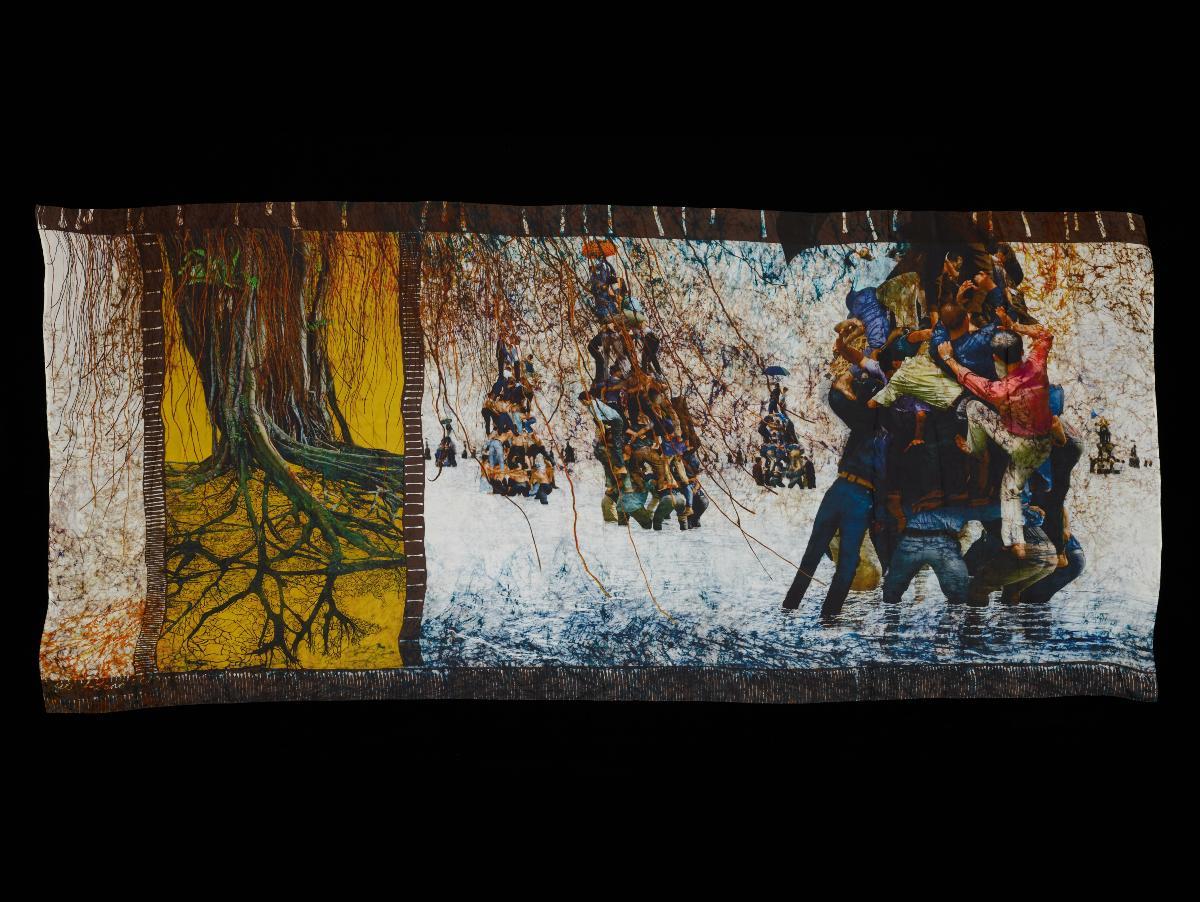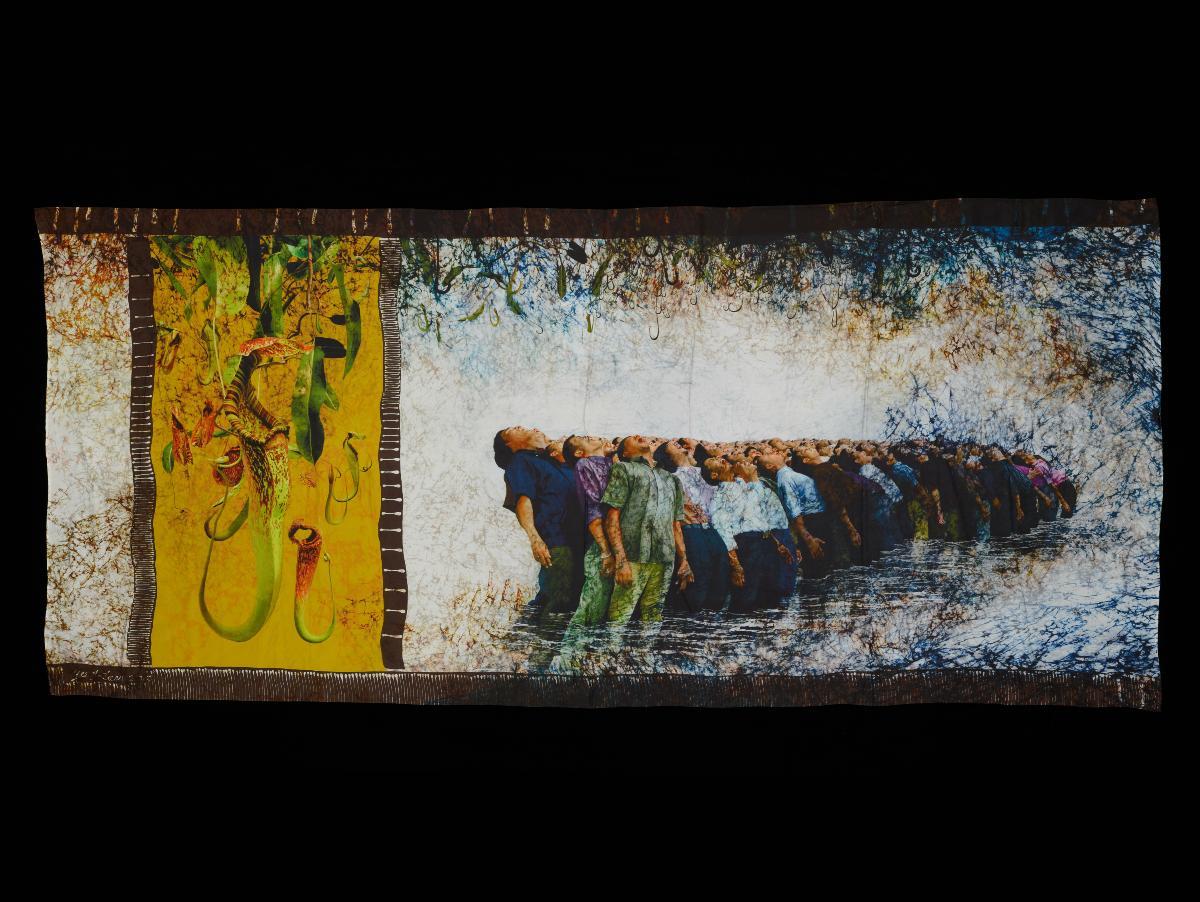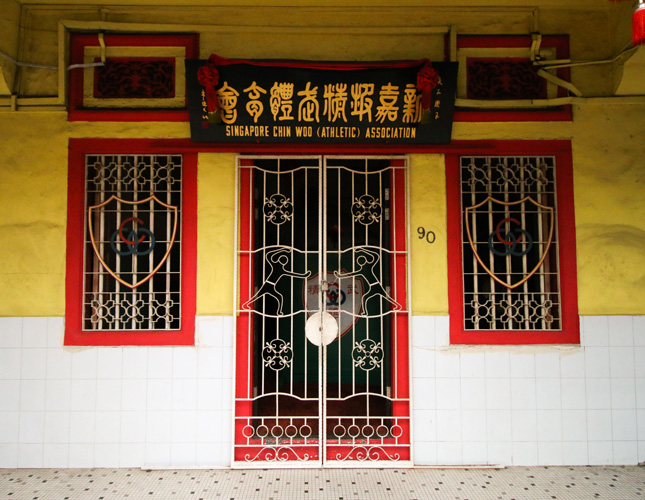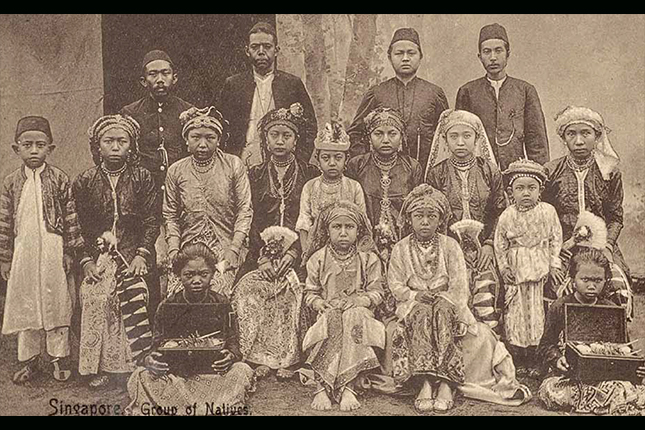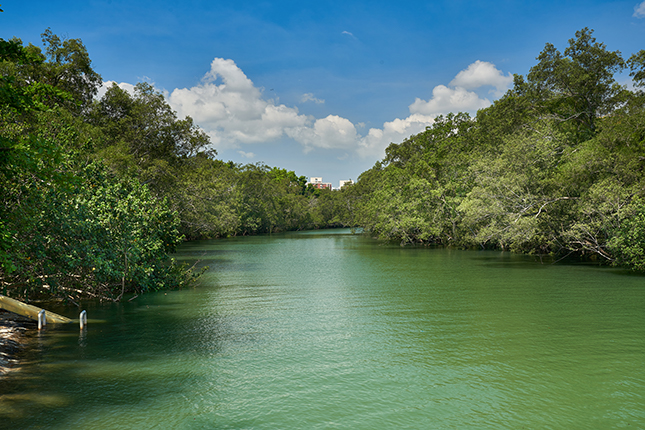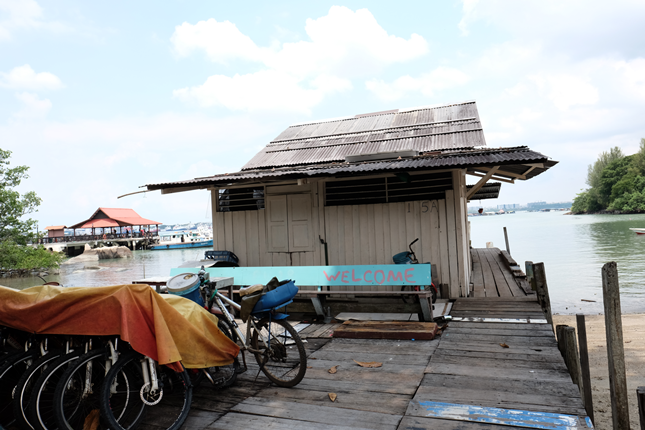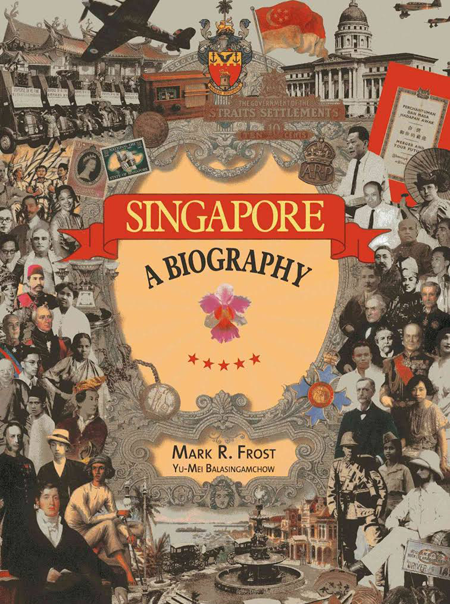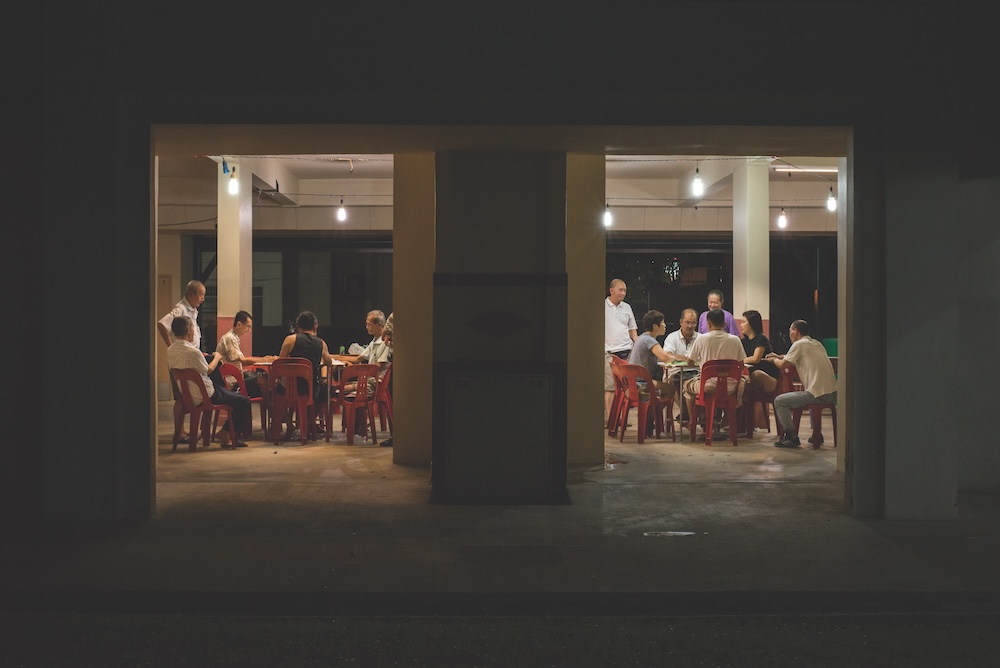+65 Volume 2 – 2022
Text by Ilya Katrinnada
Read the full +65 Vol. 2
The late morning currents are in my favour as I steer my paddleboard
towards Sungei Simpang, a river on Singapore’s northern coast. I had
started out from the sandy beaches of Sembawang Park, and Sungei Simpang
offers a drastically different scenery. Its banks are lined by mangrove
swamps with a biologically diverse ecosystem. A heron, a kingfisher, two
wild dogs, several jellyfish, and countless crabs are some of the animals I
encounter. Born and raised in post-independence Singapore’s concrete
jungle, I am unaccustomed to the sights, sounds and smells that make up this
lush and verdant intertidal zone. It is at this point that I muse: how I
wish that I possess the wisdom of the Orang Seletar, who once inhabited
these waters.
 Sungei Simpang with wooden house in background, 1981. Lee Kip Lin
Collection, courtesy of the National Library Board, Singapore.
Sungei Simpang with wooden house in background, 1981. Lee Kip Lin
Collection, courtesy of the National Library Board, Singapore.
For centuries, the Orang Seletar have called the Tebrau Strait—the thin maritime boundary that separates mainland Singapore and Peninsular
Malaysia—their home.1 As seafaring nomads, they once roamed the rivers
and wetlands of both Singapore’s northern shore and present-day
Malaysia’s southern coastline. Indeed, they are one of several
indigenous Orang Laut (meaning ‘sea people’ in Malay)
communities which trace their roots to Singapore’s pre-colonial lands
and waters, with each possessing a distinct culture and territorial
occupancy. These communities include the Orang Gelam, who lived along the
Singapore River, and the Orang Biduanda Kallang at the Kallang River. When
Stamford Raffles landed in Singapore in 1819, he noted that the Orang Laut
made up the bulk of the island’s 1,000 inhabitants. This included 200
Orang Seletar.2
 Eugen von Ransonnet,Straits of Johor and Singapore, 1869. Collection of the
National Museum of Singapore, National Heritage Board.
Eugen von Ransonnet,Straits of Johor and Singapore, 1869. Collection of the
National Museum of Singapore, National Heritage Board.
Like many indigenous communities around the world, the Orang Seletar
possess a symbiotic relationship with the natural environment. For
generations, they lived in mangrove forests and riverine zones, allowing
them to acquire a robust system of knowledge about wild animals and plants,
which provided them with crucial resources for their daily needs. They
foraged for food such as tubers and wild yams, used handmade spears to catch
fish, and hunted for wild pigs with the help of dogs.3 In the
mangrove estuaries, they sourced for wood from tall timber-producing trees
such as meranti and seraya to build their
pau kajang, or houseboats. Designed with thatched roofs made of
mengkuang (pandan) leaves, these boats were mobile homes in which
Orang Seletar slept, cooked, played, and travelled.4 They were
also experts in medicinal plants.
 Pandanus, 1803-1818. William Farquhar Collection of Natural History
Drawings. Gift of Mr G. K. Goh. Collection of the National Museum of
Singapore, National Heritage Board.
Pandanus, 1803-1818. William Farquhar Collection of Natural History
Drawings. Gift of Mr G. K. Goh. Collection of the National Museum of
Singapore, National Heritage Board.
 A group of Orang Seletar aboard their pau kajang at Seletar Island, 1950s.
The man in the middle, Pak Ketuak Buruk, was the group’s headman, whom
they called Pak Ketuak. Dr Ivan Polunin Collection, courtesy of the National
Archives of Singapore.
A group of Orang Seletar aboard their pau kajang at Seletar Island, 1950s.
The man in the middle, Pak Ketuak Buruk, was the group’s headman, whom
they called Pak Ketuak. Dr Ivan Polunin Collection, courtesy of the National
Archives of Singapore.
Between 2018 and 2019, I interviewed several members of the Orang Seletar
community currently living in Johor Bahru as part of an oral history
project. Letih, a community elder, told me that they still apply ground
nyirih (a species of mangrove in the mahogany family) to the
umbilical cord of newborns as a natural antiseptic, allowing the stump to
fall off within three days.5 Interestingly, despite having been practised by generations of Orang Seletar, this method is not
viewed favourably by hospitals today. Letih said, “Nurse[s] [will] get
angry. When we see the nurse coming, we will wash off the nyirih.
We will clean it up. When the nurse walks away, we will apply it again [on
the stump].”6 This anecdote gives us food for thought about
how indigenous knowledge is perceived in present-day medical settings.
 Mah (centre), the wife of Pak Ketuak Buruk, with her children on a pau kajang
at Seletar Island, 1950s. The boy seated on her right is now the headman
of one of the Orang Seletar villages in Johor Bahru. Dr Ivan Polunin
Collection, courtesy of the National Archives of Singapore.
Mah (centre), the wife of Pak Ketuak Buruk, with her children on a pau kajang
at Seletar Island, 1950s. The boy seated on her right is now the headman
of one of the Orang Seletar villages in Johor Bahru. Dr Ivan Polunin
Collection, courtesy of the National Archives of Singapore.
While the Orang Seletar continue to depend on the environment for their
survival, they remain conscious about not exploiting it. From my
interactions with them, I have observed that their reverential attitude
towards nature stems partly from the belief that spirits inhabit the natural
world. To appease these unseen beings, they take precautions against
extracting more resources than needed, opting to live within nature’s
bounds. For instance, even today, they will let go of animals caught if they
do not intend to eat them. During another interview, Jefree, who is an Orang
Seletar fisherman, tour guide, and photographer, said, “A fisherman
will not kill a dolphin using his spear if he does not want to eat it. He
will let it go. Following the Orang Seletar tradition, he will let go of the
dolphin so that it will bless him [with bountiful catches].”7
Their way of living is thus a truly sustainable one, in which nature, rather
than human beings, dictates everyday rhythms of growth and decline. Nature,
here, is not a force to be wrestled with, but a precarious equilibrium of
which man is but one part.8
 An Orang Seletar from a village in Johor holding onto a fish he had just
caught using a spear, 2019. Courtesy of Jefree Bin Salim.
An Orang Seletar from a village in Johor holding onto a fish he had just
caught using a spear, 2019. Courtesy of Jefree Bin Salim.
Alongside many other communities whose lives were transformed by modern
conceptions of statehood, the Orang Seletar found their nomadic lifestyle
drastically altered in the 20th century. A major turning point was the
separation of Singapore from Malaysia in 1965. With the establishment of
borders between the two nations, the Orang Seletar were eventually no longer
able to travel freely on their pau kajang across the Tebrau Strait.
Interestingly, Orang Seletar who became Malaysian citizens were still given
permission to cross the Strait until 1987.9 However, all access ceased after the arrest of an Orang Seletar who was caught allegedly
smuggling illegal goods.10Many Orang Seletar who still
inhabit coastal villages in Johor now make a living by fishing and rearing
mussels, though their catches have been dwindling in recent years due to
environmental degradation. Their fibre boats provide them easy access to what
is left of Johor’s mangrove swamps, which remain untouched by land
reclamation and urban development for now.

Several Orang Seletar hunting for wild boar in the mangroves of Sungei
Melayu in Johor Bahru, 2019. Courtesy of Jefree Bin Salim.
In Singapore, the Orang Seletar lived in various coastal settlements at the
mouth of the Kranji and Kadut rivers and on Seletar Island during our early
post-independence years. When these areas were slated for development, some moved up north to Johor. Others eventually
assimilated into the local Malay community, leaving behind their seafaring and
boat-dwelling lifestyle.11 What remains are various toponyms which
contain their namesake, such as Seletar Reservoir, Seletar Aerospace Park and
Seletar River.

The writer and her friend on a paddleboard expedition to the mangroves of
Sungei Simpang, 2020. Courtesy of Outdoor & Adventure Learning Pte Ltd
(OAALSG).
As I paddled away from the swamps of Sungei Simpang back to Sembawang Park,
I caught sight of Seletar Island. This was one of the places where the Orang
Seletar used to gather, docking their pau kajang side by side along
the shores. I looked around me and saw other outdoor enthusiasts.
Paddleboards, kayaks, and speedboats have replaced the sights of
pau kajang that used to ply these waters. It is encouraging to
observe urban dwellers still find ourselves wanting to be in nature. We may
not be as intimately connected with the natural world as the Orang Seletar,
but perhaps being regularly in touch with the waters that surround our
island-nation could be a good start.
Ilya Katrinnada is an educator and writer with a keen interest in the
intersections of creativity, community, and education. Between 2018 and
2019, she was part of a 3-woman independent research team which collected
oral history interviews from the Orang Seletar community in Johor Bahru.
These interviews were used in a verbatim play, Tanah•Air 水•土: A Play In Two Parts, which was presented by Drama Box in 2019 as part of the Singapore
Bicentennial. She has also written about the history of the Orang Seletar in
the Apr–Jun 2022 issue of BiblioAsia, a publication of the National
Library of Singapore.













